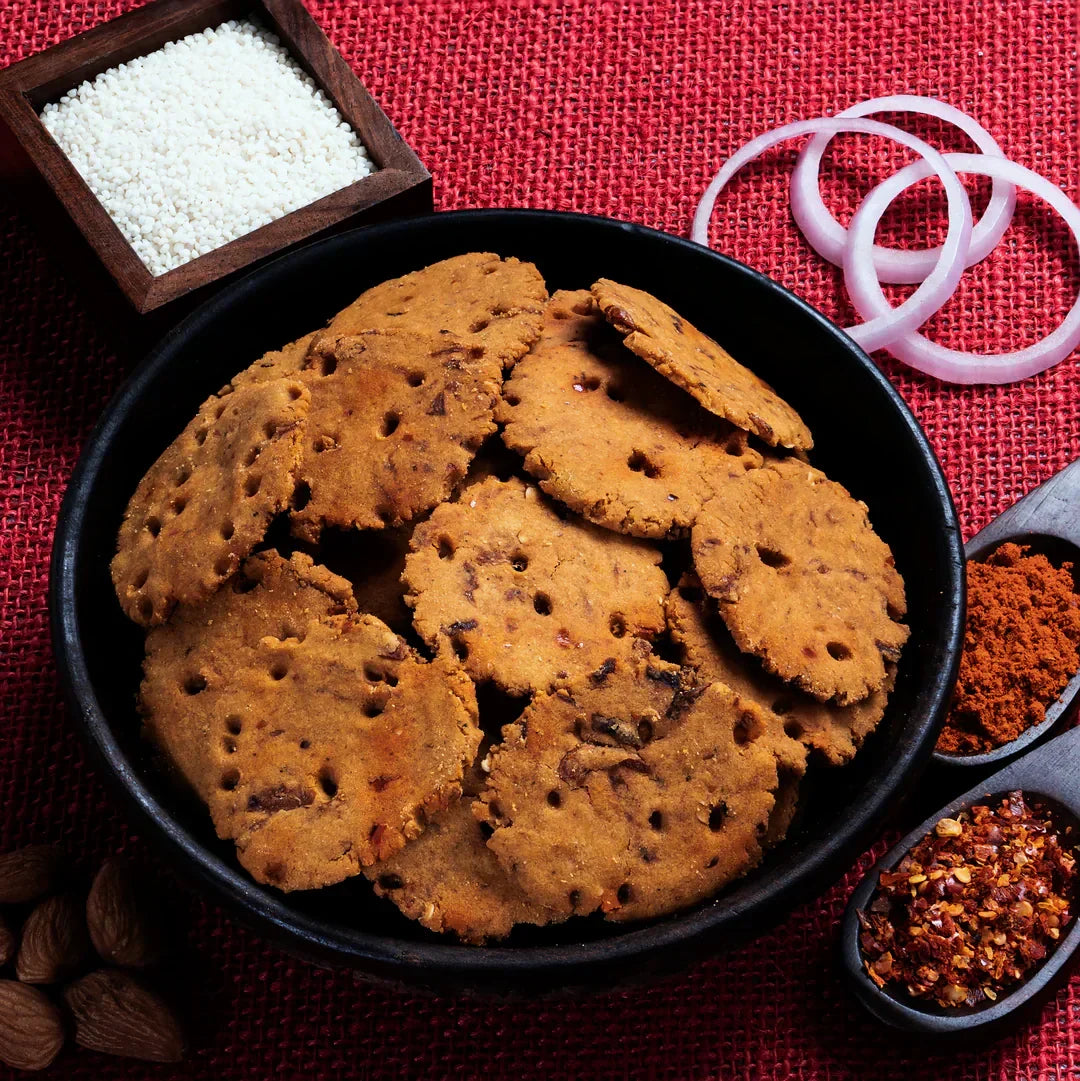
Authentic Thattai Recipe
Share
Known by various names thattai in Tamil, nippattu in Kannada, and chekkalu in Telugu, the savoury fried snack is a South Indian treat. In some parts of Southern India,it is often religiously and culturally significant in that it is prepared during the festivals like Gokulashtamin and Diwali. This crunchy and tasty delight can be served alongside your evening tea and is worth making at home.
Ingredients Needed for Thattai
Thattai has been a staple snack in South Indian households, especially during festivals. The combination of flours, lentils, and spices creates a deep-fried delicacy that is both crunchy and flavorful.
Flour Base:
-
Rice Flour – Ensures a crisp finish
-
Urad Dal Flour – Enhances texture and flavor
Flavor Enhancers:
-
Chili Powder or Black Pepper – Brings in heat
-
Curry Leaves & Asafoetida – Adds depth of flavor
-
Sesame Seeds & Chana Dal – Provide a crunchy contrast
Binding & Cooking Elements:
-
Butter/Ghee – Adds richness
-
Salt & Water – For dough consistency
-
Oil – For frying
Different regions have their own take on thattai. Some use black pepper instead of chili powder for a bolder taste, while others like the Rajapalayam-style include garlic for an extra layer of flavor.
Step-by-Step Guide to Making Thattai
-
Step 1: Preparing the Dough – The Secret to Crispiness
The right mix of rice flour, urad dal flour, spices, and ghee is crucial. Soaked chana dal and sesame seeds enhance crunch. A well-kneaded, non-sticky dough ensures perfect results.
-
Step 2: Shaping – Traditional & Modern Techniques
While hand-flattening is the authentic way, you can also use a rolling pin for uniform thickness. Greasing your hands with oil helps in shaping smooth, crack-free discs.
-
Step 3: Frying – The Final Touch
Patience is key—fry in medium-hot oil, flipping gently for even cooking. Perfect thattai should be light, crisp, and golden brown.
Tips for Perfect Thattai
Use fine rice flour – Homemade raw rice flour gives the best crunch.
Ensure correct dough consistency – Firm yet pliable, not too dry or sticky.
Avoid excess water – Too much makes the thattai chewy.
Grease surface before shaping – Use butter paper or banana leaves to prevent sticking.
Maintain medium oil temperature – Too hot burns the outside, too low makes it soggy.
Test oil before frying – Drop a small dough piece; it should rise slowly.
Fry in small batches – Ensures even cooking and crispiness.
Cool completely before storing – Moisture can make them lose crunch.
Store in an airtight container – Keeps them crispy for longer.
Variations of Thattai (Optional Ingredients)
Adjusting spice levels can make a significant difference in the taste of thattai. Masala Thattai is perfect for those who love bold flavors, featuring a mix of crushed garlic, fennel seeds, red chili powder, and asafoetida. The result is a highly aromatic and spicy snack that pairs perfectly with evening tea.
If you prefer a milder taste, Classic Mild Thattai tones down the spice by using only a small pinch of red chili powder and a dash of cumin for subtle flavor enhancement, making it suitable for children and those with a low spice tolerance.

How to Serve and Store Thattai
Thattai is best enjoyed with a cup of hot tea or coffee. It also pairs well with coconut chutney or spicy pickle for added flavor.
To keep thattai crispy, store it in an airtight container at room temperature. Avoid moisture, as it can soften the texture. Properly stored, it stays fresh for up to 3 weeks.
A Healthier Take on Thattai
Thattai, when made with minimal oil and quality ingredients, can be a wholesome snack. Using roasted gram flour and sesame seeds adds protein and fiber, making it a better choice than deep-fried chips.
For a healthier twist, try baked thattai instead of deep-fried. Whole grain flours like millets or whole wheat can boost its nutritional value.
At Millet Maagic Meal, we've always tried to combine health & taste, check out our healthy range of thattai here.
FAQs about Thattai
Can I make thattai without urad dal flour?
Yes, you can make thattai without urad dal flour, but it plays a role in enhancing the crispiness. You can substitute it with roasted gram flour (pottukadalai maavu) for a similar effect. If skipped entirely, the texture may be slightly harder and less airy.
How can I make vegan or gluten-free thattai?
Thattai is naturally vegan as it doesn’t contain dairy or animal-based ingredients. However, for a gluten-free version, replace rice flour with millet flour, chickpea flour, or any other gluten-free alternative. Keep in mind that the texture might vary slightly, and adjustments in water quantity may be needed.
What’s the best oil for frying thattai?
Cold-pressed peanut oil gives thattai an authentic South Indian flavor, while coconut oil adds a hint of sweetness. Sunflower or vegetable oil is a neutral option that keeps the taste light. Avoid oils with low smoke points, as they may alter the texture or make the thattai greasy.
While thattai is fried in oil, its healthier version made by baking it is a nutritious alternative to the traditional version. Make this recipe at home and store it in an air tight container and it can last almost a month and ll serve you right as a great snacking option. Go ahead and give this a try!
Liked this article? Follow our other blogs for awesome and healthy millet recipes and benefits!
Check out our range of gluten free, healthy millet delights here
